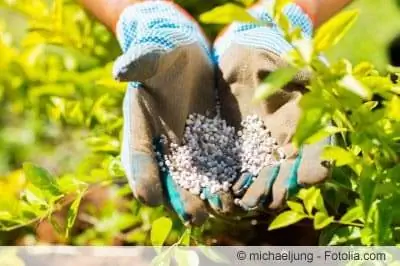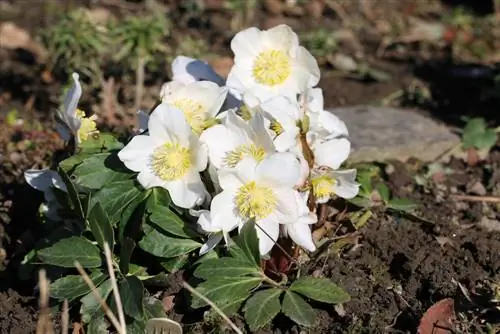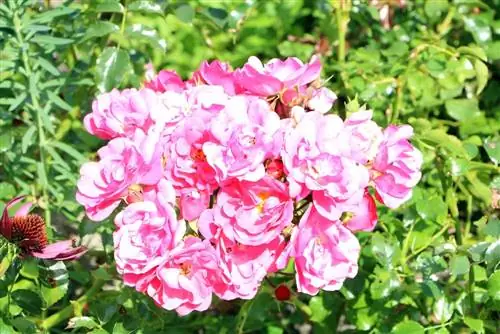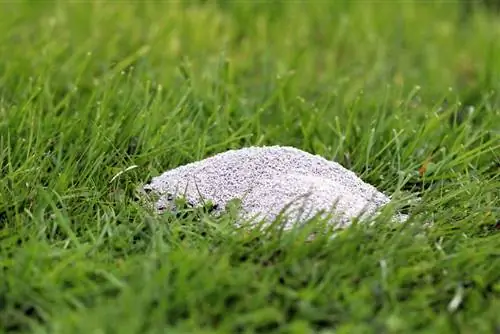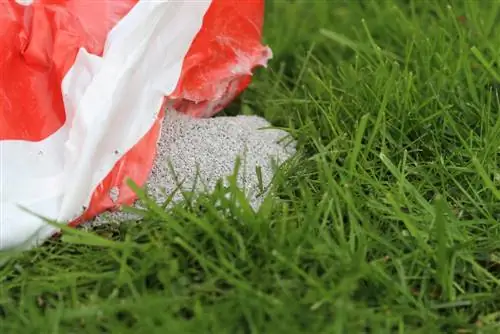- Author admin [email protected].
- Public 2023-12-17 03:39.
- Last modified 2025-01-24 12:45.
One of the main pillars of autumn plant care is proper preparation for frosty temperatures. The pivotal point is a balanced supply of nutrients. Now the focus is not on lush growth or the wasteful abundance of flowers. Instead, it is important to strengthen the garden's plants so that even extreme fluctuations between frost and thaw do not cause the tissue cells to burst. The following instructions show you how to properly fertilize roses, shrubs and conifers in autumn.
Potassium creates winter hardiness
A look at the composition of special autumn fertilizers shows that potassium is one of the main components. For good reason, because potassium fulfills a variety of tasks in supplying plants with nutrients. As one of the ten most common elements in the earth's crust, potassium was nicknamed 'plant ash' because our ancestors used wood ash as potassium fertilizer. The nutrient makes a valuable contribution to the transport of water in the plant pathways, optimizes the water pressure in the roots and promotes photosynthesis.
The outstanding advantage of potassium for plant metabolism is that it strengthens frost resistance. The element accumulates in the plant cells, whereupon the s alt content in the cell sap increases. As is well known, s alt in higher concentrations always reduces the freezing point. The tissue cells benefit from this effect, so that frosty temperatures cannot affect them so quickly. In addition, plants supplied with potassium are better equipped to withstand the intensive stresses of frost and thaw and vice versa.
Fertilize roses, shrubs and conifers with Patentpotash
In order to properly fertilize ornamental plants in autumn, potassium should be present in sufficient quantities. Patentkali has proven itself as a premium preparation among autumn fertilizers for many years. The fertilizer is characterized by a balanced combination of 30 percent potassium, 10 percent magnesium and 15-17 percent sulfur. Known under the name Kalimagnesia, the product is frequently used in both professional gardening and hobby gardening. In contrast to cheap offers, Patentkali meets the requirements of s alt-sensitive roses, shrubs and conifers. At the same time, the fertilizer eliminates the increasing lack of sulfur, which is increasingly rarely present in sufficient concentration as a nutrient in the soil. Together with magnesium, these two nutrients ensure lush green leaves and colorful flowers. How to properly fertilize your plants with Kalimagnesia:
- Fertilize roses between mid and end of August with 40 grams per square meter
- Fertilize shrubs and conifers in September/October with 30-50 grams per square meter
- Apply the water-soluble granules by hand or with a spreader
- Immediately work in superficially with a rake and water sufficiently
When choosing the right time, please note that the plant is still in the growth phase. Otherwise the nutrients cannot be absorbed properly.
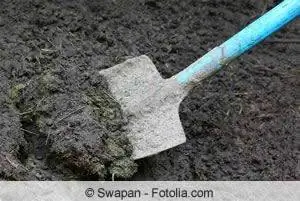
To fertilize potted plants with patent potash in autumn, the preparation is first dissolved in water. It is administered directly to the root area so that the solution does not reach leaves and flowers. If the substrate has dried several centimeters deep, first water with clear water to apply the fertilizer to moistened soil. This precaution applies regardless of whether the plant is in a bed or a pot.
Tip:
If pale leaves, selective leaf discoloration or leaf edge necrosis develop on ornamental plants during the year, this damage indicates a lack of potassium. Undesirably compressed growth can also be attributed to a lack of this nutrient. The immediate administration of Patentkali in a dosage of 50 to 80 grams per square meter compensates for the deficiency.
More potassium fertilizers for autumn
With DCM Vivikali, specialist retailers offer an option for Patentkali. This product is approved for organic farming in accordance with EU regulations and is used there as an autumn fertilizer to harden off ornamental and useful plants. With 20 percent potassium, the preparation has a slightly lower dosage and does not contain any magnesium.
Where half the dosage of potassium is sufficient for autumn, polysulfate can also be considered. This raw potassium s alt has a very stable calcium shell that only gradually breaks down. Therefore, the release of the nutrient occurs more slowly over the winter. The content of sulfur and magnesium is at the level of patent potassium.
Natural alternative to Kalimagnesia
Environmentally conscious hobby gardeners shy away from using fertilizers from store shelves. Instead, they rely on self-made fertilizers with purely natural ingredients. The prime example of a potassium-rich fertilizer for autumn is comfrey manure. After nettle manure supplied your roses, shrubs and conifers with nitrogen and phosphorus in spring and summer, comfrey manure serves as a logical continuation to strengthen them before winter. It is easy to prepare using this tried and tested recipe:
- All above-ground plant parts can be used
- In a wooden tub, stir in 1,000 grams of crushed comfrey plants in 10 liters of water
- Cover the container with wire mesh or a loosely placed lid
- Allow to ferment in a warm, sunny place for 10 to 14 days
- The addition of stone powder, valerian or chamomile reduces the unpleasant smell
- Stir the mixture daily with a wooden stick
If the broth turns brown, the fermentation process is complete. Now the comfrey manure is strained and stored in a partially shaded to shady place.
Starting at the end of July/beginning of August, fertilize roses, shrubs and conifers every 14 days with comfrey manure, which has previously been diluted in a ratio of 1:10. For species and varieties that tolerate foliar fertilization, administer the natural autumn fertilizer diluted in a ratio of 1:50.
Tip:
If there is a permanent lack of potassium in the garden soil, the compost heap is watered every 14 days with undiluted comfrey manure. With every addition of compost, your ornamental and crop plants automatically receive a portion of potassium without being exposed to the risk of over-fertilization.
Soil analysis prevents over-fertilization

In organically managed ornamental and kitchen gardens, fertilizers are only used when there is an actual need. This protects the environment and your wallet at the same time. In addition, over-fertilization often has the opposite effect and causes more harm than good. Prudent hobby gardeners therefore order a soil analysis every 3 to 4 years, which provides far more information than the standard pH value test. The result clearly shows the extent to which the most important soil nutrients are present, such as nitrogen, magnesium, potassium, sulfur or phosphorus. In addition, the commissioned laboratory provides a well-founded fertilizer recommendation, specifically tailored to your garden. The analysis is so uncomplicated:
- 10-15 soil samples are taken from different locations and placed in a container
- Thoroughly mixed, 500 grams of soil goes into a bag
- The laboratory learns all important details about the samples via an included data collection form
The sample is sent to the institute by post in a sturdy shipping box. After an average of 2-3 weeks you will have the written result in your hands.
Conclusion
Potassium reduces winter stress on plants caused by frosty temperatures and permanent wetness. The natural element strengthens the tissue cells so that even repeated fluctuations between freezing and thawing weather do not cause damage. Patentkali has proven to be excellent for properly fertilizing roses, shrubs and conifers in autumn. The fertilizer known as potassium magnesia also contains sulfur and magnesium, other important nutrients for the cold season and a he althy start to the next season. Biologically oriented hobby gardeners use home-made comfrey manure instead of patent potash, rich in natural potassium and without the risk of over-fertilization. A professional soil analysis every 3-4 years determines whether there is even a need for fertilizers.

